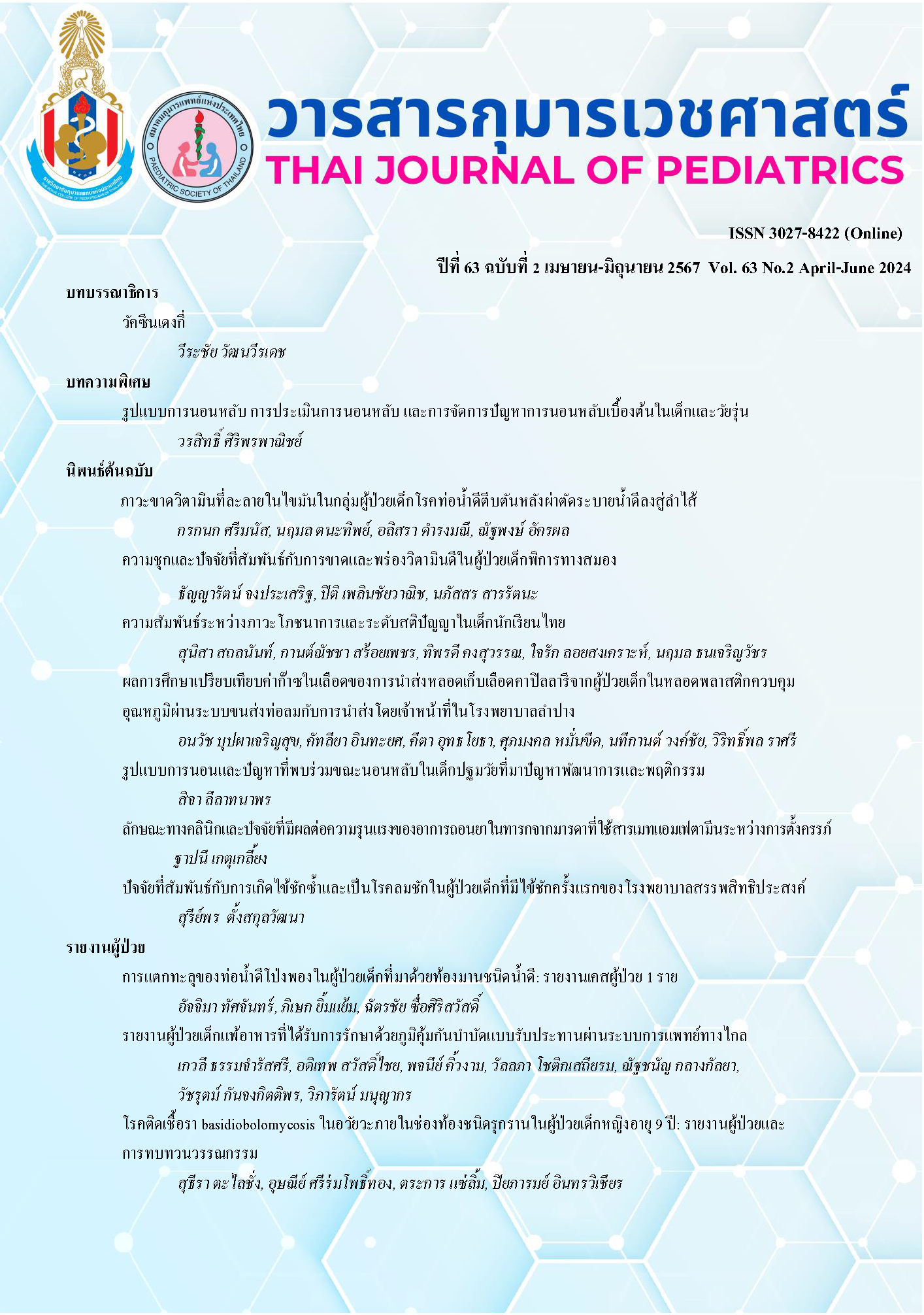Outcomes of transporting of blood gas capillary tube samples from pediatric patients using a customized container through a pneumatic tube system compared with delivering in-person to the clinical laboratory unit, Lampang hospital
Keywords:
customized container, blood gas values, pneumatic tube system, hospital couriers, experimental studyAbstract
Background: Currently, the pneumatic tube system is used in the hospitals to reduce the transportation time of documents, medicines, and medical supplies. However, the transportation of blood gas within hospitals still depends on available hospital couriers, who may take long transport distances and cannot accommodate the moving promptly. Additionally, there is a lack of comparative data on blood gas values in pediatric patients transported via the pneumatic tube system versus hospital couriers.
Objectives: To compare the differences in blood gas transit time, blood gas values and transportation cost between a transit of blood gas sample via the customized container through pneumatic transportation system and via hospital couriers.
Method: An experimental study was conducted to compare the differences in blood gas transit time, blood gas values, and transportation costs between customized container through a pneumatic transportation system and hospital couriers for infants weighing 2 kilograms or more who needed blood gas analysis. Each sample of blood gas were transported by using both methods. Data were collected from 25 pairs of arterial blood gas samples and 36 pairs of venous blood gas samples from May 27 to December 5, 2023.
Result: Among 61 pairs of blood gas, mean + SD of transportation time by pneumatic tube system and by hospital couriers were 61.6 ± 4.9 and 148.2 ± 46.5 seconds, respectively (p value <0.001). Arterial and venous blood gas analyses (pH, PO2, PCO2 and HCO3 values) showed no statistically significant difference (p value <0.001) between the two transportation methods. There were no complications (hemolysis, clotting and air contamination) during blood gas transportation on both methods. The transportation cost using the pneumatic tube system was about half that of hospital couriers (approximately 27.5 and 50 Baht per round, respectively)
Conclusion: The blood gas values from transportation by customized container through pneumatic tube system did not differ from hospital couriers, and the transportation cost using the pneumatic tube system was lower than that of hospital couriers.
Downloads
References
Poznanski W, Smith F, Bodley F. Implementation of a pneumatic-tube system for transport of blood specimens. Am J Clin Pathol. 1978;70:291-5.
Carabini LM, Nouriel JE, Milian RD, Glogovsky ER, McCarthy RJ, Handler TG, et al. The clinical significance of patient specimen transport modality: Pneumatic tube system impact on blood gas analytes. Respir Care. 2016;61:1311-5.
Fernandes CM, Worster A, Eva K, Hill S, McCallum C. Pneumatic tube delivery system for blood samples reduces turnaround times without affecting sample quality. J Emerg Nurs. 2006;32:139-43.
Kapoula GV, Kontou PI, Bagos PG. The impact of pneumatic tube system on routine laboratory parameters: A systematic review and meta-analysis. Clin Chem Lab Med. 2017;55:1834-44.
รัตนบุญกาญจน์. ป. การประดิษฐ์อุปกรณ์ใส่ตัวอย่างเลือด blood gas สำหรับนำส่งทางท่อลม.2563:18-20.
Biswas CK, Ramos JM, Agroyannis B, Kerr DN. Blood gas analysis: Effect of air bubbles in syringe and delay in estimation. Br Med J (Clin Res Ed). 1982;284:923-7.
Johnson KJ, Cress GA, Connolly NW, Burmeister LF, Widness JA. Neonatal laboratory blood sampling: Comparison of results from arterial catheters with those from an automated capillary device. Neonatal Netw. 2000;19:27-34.
Cousineau J, Anctil S, Carceller A, Gonthier M, Delvin EE. Neonate capillary blood gas reference values. Clin Biochem. 2005;38:905-7.
Garcia LO, Speransa DMR, Rodrigues CB, Benites RM, García MTC, Sekine L, et al. Validation of blood components transport through a pneumatic tube system. Hematol Transfus Cell Ther. 2021;44:519-25.
Ellis G. An episode of increased hemolysis due to a defective pneumatic air tube delivery system. Clin Biochem. 2009;42:1265-9.
Evliyaoğlu O, Toprak G, Tekin A, Başarali MK, Kilinç C, Colpan L. Effect of pneumatic tube delivery system rate and distance on hemolysis of blood specimens. J Clin Lab Anal. 2012;26:66-9.
Kara H, Bayir A, Ak A, Degirmenci S, Akinci M, Agacayak A, et al. Hemolysis associated with pneumatic tube system transport for blood samples. Pak J Med Sci. 2014;30:50-8.
Slavík L, Úlehlová J, Bradáčová P, Chasáková K, Hluší A, Palová M, et al. The modern pneumatic tube system transports with reduced speed does not affect special coagulation tests. J Med Syst. 2020;44:142.
Subbarayan D, Choccalingam C, Lakshmi CKA. The effects of sample transport by pneumatic tube system on routine hematology and coagulation tests. Adv Hematol. 2018;2018:6940152.
Downloads
Published
How to Cite
Issue
Section
License
Copyright (c) 2024 The Royal College of Pediatricians Of Thailand

This work is licensed under a Creative Commons Attribution-NonCommercial-NoDerivatives 4.0 International License.



